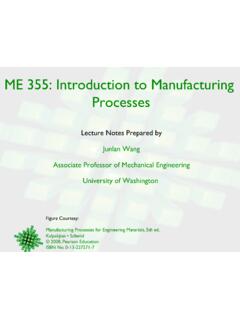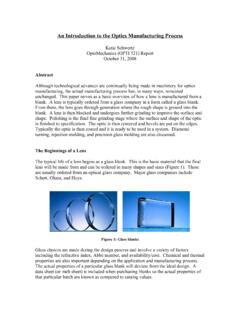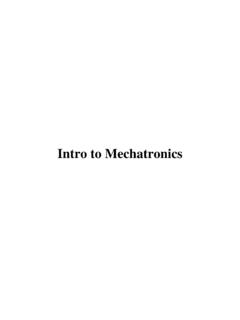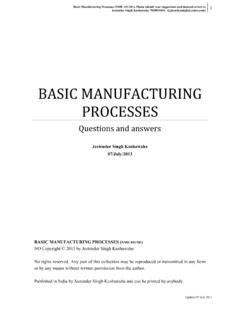Transcription of International Journal of Engineering Research and General ...
1 International Journal of Engineering Research and General Science Volume 2, Issue 4, June-July, 2014. ISSN 2091-2730. Application of 7 Quality Control (7 QC) Tools for Continuous Improvement of manufacturing processes Varsha M. Magar 1, Dr. Vilas B. Shinde2. 1. Research Scholar (PG), Department of Mechanical Engineering , Datta Meghe College of Engineering , Mumbai University 2. Professor, Department of Mechanical Engineering , Datta Meghe College of Engineering , Mumbai University E-mail- Abstract In this paper a review of systematic use of 7 QC tools is presented.
2 The main aim of this paper is to provide an easy introduction of 7 QC tools and to improve the quality level of manufacturing processes by applying tools are the means for Collecting data , analyzing data , identifying root causes and measuring the results. these tools are related to numerical data processing .All of these tools together can provide great process tracking and analysis that can be very helpful for quality improvements. These tools make quality improvements easier to see, implement and track. The work shows continuous use of these tools upgrades the personnel characteristics of the people involved.
3 It enhances their ability to think generate ideas, solve problem and do proper planning. The development of people improves the internal environment of the organization, Which plays a major role in the total Quality Culture. Keywords QC Tools , continuous improvement , manufacturing processes ,Quality control , Root Cause analysis ,PDCA,Efficiency introduction . The 7 QC Tools are simple statistical tools used for problem solving. These tools were either developed in Japan or introduced to Japan by the Quality Gurus such as Deming and Juran. In terms of importance, these are the most useful.
4 Kaoru Ishikawa has stated that these 7 tools can be used to solve 95 percent of all problems. These tools have been the foundation of Japan's astomishing industrial resurgence after the second world war. For solving quality problems seven QC tools used are Pareto Diagram, Cause & Effect Diagram ,Histogram, Control Charts , Scatter Diagrams, Graphs and Check Sheets . all this tools are important tools used widely at manufacturing field to monitor the overall operation and continuous process improvement. This tools are used to find out root causes and eliminates them , thus the manufacturing process can be improved.
5 The modes of defects on production line are investigated through direct observation on the production line and statistical tools. Methodology For solving quality problems following seven QC tools are required 1. Pareto Diagram 2. Cause & Effect Diagram 3. Histogram 4. Control Charts 5. Scatter Diagrams 6. Graphs 364 International Journal of Engineering Research and General Science Volume 2, Issue 4, June-July, 2014. ISSN 2091-2730. 7. Check Sheets 1) Pareto Diagram Pareto Diagram is a tool that arranges items in the order of the magnitude of their contribution, thereby identifying a few items exerting maximum influence.
6 This tool is used in SPC and quality improvement for prioritizing projects for improvement, prioritising setting up of corrective action teams to solve problems, identifying products on which most complaints are received, identifying the nature of complaints occurring most often, identifying most frequent causes for rejections or for other similar purposes. The origin of the tool lies in the observation by an Italian economist Vilfredo Pareto that a large portion of wealth was in the hands of a few people. He observed that such distribution pattern was common in most fields.
7 Pareto principle also known as the 80/20 rule is used in the field of materials management for ABC analysis. 20% of the items purchased by a company account for 80% of the value. These constitute the A items on which maximum attention is paid. suggested the use of this principle to quality control for separating the "vital few" problems from the "trivial many" now called the "useful many". Procedure : The steps in the preparation of a Pareto Diagram are : 1. From the available data calculate the contribution of each individual item. 2. Arrange the items in descending order of their individual contributions.
8 If there are too many items contributing a small percentage of the contribution, group them together as "others". It is obvious that "others" will contribute more than a few single individual items. Still it is kept last in the new order of items. 3. Tabulate the items, their contributions in absolute number as well as in percent of total and cumulative contribution of the items. 4. Draw X and Y axes. Various items are represented on the X-axis. Unlike other graphs Pareto Diagrams have two Y-axes - one on the left representing numbers and the one on right representing the percent contributions.
9 The scale for X-axis is selected in such a manner that all the items including others are accommodated between the two Y-axes. The scales for the Y-axes are so selected that the total number of items on the left side and 100% on the right side occupy the same height. 5. Draw bars representing the contributions of each item. 6. Plot points for cumulative contributions at the end of each item. A simple way to do this is to draw the bars for the second and each subsequent item at their normal place on the X-axis as well as at a level where the previous bar ends.
10 This bar at the higher level is drawn in dotted lines. Drawing the second bar is not normally recommended in the texts. 7. Connect the points. If additional bars as suggested in step 6 are drawn this becomes simple. All one needs to do is - connect the diagonals of the bars to the origin. 8. The chart is now ready for interpretation. The slope of the chart suddenly changes at some point. This point separates the 'vital few'. from the 'useful many' like the A,B and C class items in materials management. 2) Cause & Effect Diagram A Cause-and Effect Diagram is a tool that shows systematic relationship between a result or a symptom or an effect and its possible causes.







